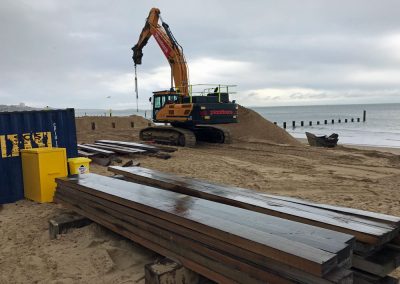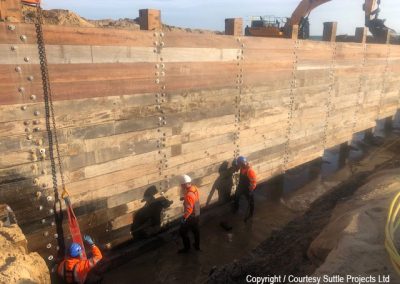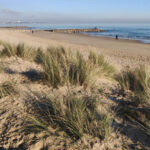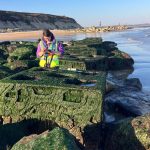Completed Projects
Timber Groyne renewal programme, winter 2020/21
Year 1 of a two-year, £1.84 million programme to renew eight timber groynes from the boundary of Poole/Bournemouth to West Cliff zig-zag
LEAD AUTHORITY
BCP Council
WORKING WITH
START DATE
October 2020
END DATE
15th March 2021
Project Overview
All 53 timber groynes along Bournemouth’s beaches are being renewed, in multiple short phases, as part of the Poole Bay Beach Management Scheme 2015-2032
The fourth short phase (and Year 1 of a two-year project) took place from October 2020-March 2021. The works area stretched from the Poole/Bournemouth boundary to Middle Chine. Five groynes were deconstructed, and were replaced by four more evenly spaced ones.
Our contractors, Suttle Projects Ltd, were on site from Monday to Saturday, during normal site working hours. They worked with the lowest tides on a rota system, which meant some work took place outside daylight hours. We anticipated this first phase of the groyne renewal project would be completed by spring 2021, subject to weather conditions and working arrangements based on latest Covid-19 guidance. We finished three weeks earlier than planned thanks to operating efficiencies.
Work on the remaining four groynes is scheduled to start autumn 2021, completing spring 2022.
Deconstructing and reconstructing a timber groyne – how it’s done
Please enlarge images in the gallery for a description of the process
Visitor access & safety
Access to beach huts is retained. Alumhurst Road car park remains open. Access along the promenade is maintained to allow visitors to safely pass the works, but the beach construction area will be closed for safety reasons.
Heavy machinery will be operating on the beach. Sand becomes very unstable when it is excavated around groynes; for this reason, we ask visitors not to pass the construction zone along the water’s edge, even at low tide. Dogs should be kept on a lead.
Once work is finished, restrictions will remain in place until the sand dries out and becomes more compact and stable underfoot. Small ledges may appear where the sand meets the sea, but wave action will soon sort the sand into a natural beach profile.
Timber used for the new groynes
Each new groyne will be constructed using a mix of new tropical hardwood timber and recycled tropical hardwood planking, from previously deconstructed timber groynes, when available.
Hardwoods used will be Greenheart - a pale yellow to dark olive green wood from Guyana, South America, and Ekki - a dark red / deep chocolate-brown wood from West Africa and the Congo. These timbers have been selected for their strength, durability and resistance to marine life which can destroy wood by boring into and eating it.
What's eating our timber groynes?
Gribble! These tiny worms (Limnoria terebrans) were first discovered in 1799 and they attack marine timbers. Gribble burrow into groyne timbers, creating long tunnels just beneath the surface; the holes they leave behind eventually weaken the wood, causing it to crumble and rot. This is one of the reasons we renew our groynes every 25 years approx.
Gribble resemble tiny yellowy-pink lice about the size of a grain of rice, but they are actually very small crustaceans. Crustaceans are animals that usually have a hard covering, or exoskeleton, jointed legs and two pairs of antennas, or feelers. Other examples of crustaceans are crabs, lobsters, shrimps, and barnacles.
FUNKY FACTS ABOUT POOLE BAY GROYNES
A total of 29 piles are sunk for a timber groyne, each pile is 10m long and spaced 2.5m apart. The King pile (out at sea) is 12.5m long. Piles are driven down to the first solid layer of stable substrate/clay. Each groyne is between 5m-7.5m deep and roughly 75m in length. Approximately 225 planks of timber make up a groyne. Generally only the top 5 rows are constructed using new timber; recycled timber is used for the bottom 12-14 rows. Timbers unsuitable for re-use on new groynes are recycled for other projects; for example in 2022, for cladding and decking at the Environmental Hub at Durley Chine, and as part of a footbridge created at a flooded wetland scheme in the Tamar Valley AONB, Cornwall.
You'll find more information on projects that reuse BCP groyne timber at our Recycling & Reusing page.
Environmental considerations
All the groyne renewal works will be carried out in accordance with the Marine Management Organisation licence and planning consent. Additionally, new tropical hardwood timber used for this project is certified sustainable by the Forestry Stewardship Council (FSC).
The old groynes will be carefully deconstructed to ensure that all suitable materials can be recovered and recycled or re-used in future coastal projects.
Groynes - their role in coast protection
Beach material generally moves from west to east in Poole Bay. The strategically placed groynes are renewed approximately once every 25 years and slow down the natural processes. Piling and planking deep into the beach to the first solid layer of substrate/clay helps retain the sand within the groyne field.
In combination with periodic beach renourishment (topping-up the beach levels) the groynes also help protect the seawalls and cliffs from erosion. We last renourished some of the beaches from Poole to Southbourne in early 2021 [project details here].
Previous phases of timber groyne renewal:
- Winter 2017/18 and 2018/19 – 12 groynes at Southbourne
- Winter 2016/17 – 8 groynes eastwards from Fisherman’s Walk to Gordon’s Corner
- Winter 2015/16 – 10 groynes from the east of Boscombe Pier to Fisherman’s Walk










